ARE NATURAL REFRIGERANTS THE ONLY SURE BET?
AIM ACT ADVANCES AS INDUSTRY PREPARES FOR HFC PHASEDOWN
THE AIM ACT ADVANCES
THE U.S. ENVIRONMENTAL PROTECTION AGENCY HAS FINALIZED THE SECOND REGULATION UNDER THE AMERICAN INNOVATION AND MANUFACTURING ACT, ADVANCING RULES THAT WILL RESTRICT THE USE OF HYDROFLUOROCARBONS.
“With the second regulation finalized, the EPA is addressing technology transition. It previously focused on production and consumption and will next consider and rule on refrigerant management.
“We have two legs of the three-legged stool of the AIM Act now finalized, and the third leg now proposed” said Tristam Coffin, co-founder of Effecterra and president of sustainability, policy and technical services.
Gary Schrift, president of IIAR, said AIM solidifies the nation’s commitment to phasing out hydrofluorocarbon refrigerants in the same manner that ozone-depleting hydrochlorofluorocarbon refrigerants were phased out.
“Natural refrigerants have a big opportunity to be the hero of the AIM Act,” said Danielle Wright, executive director of the North American Sustainable Refrigeration Council.
Those within the natural refrigerant space said the phasedown will create potential for growth. “People in our industry that support and understand natural refrigerants should be optimistic about the newer markets that become available,” said David Fauser, director of sales at Cimco Refrigeration. “As the economy slows in certain areas, such as food and beverage, now there is a whole new world of opportunities.”
The AIM Act has focused on three areas: production and consumption, technology and transitions, and, most recently, refrigerant management. “Each use sector has different timelines and refrigerant global-warming potential levels for reduction and phaseout,” Schrift said.
The EPA has taken lessons from the European Union, which experienced price spikes and limited availability of refrigerants. EPA is “putting actions in place to help manage demand and hopefully not see the same volatility the EU saw,” Coffin said.
The first of the final rules, which focuses on the phasedown of production and consumption, was published July 20, and the first major phase down under the rule is coming on Jan. 1. “It is a 40 percent reduction in supply. The refrigerants with the highest GWP [global-warming potential] will be targeted first,” Coffin said.
The rule authorizes EPA to slash U.S. production and consumption of HFCs by 85 percent by 2036. The phasedown is consistent with the Kigali Amendment to the Montreal Protocol, and establishes a baseline and methodology for allocating and trading HFC allowances and creates compliance and enforcement systems.
EPA finalized the second rule, which focuses on technology transitions, on Oct. 6. The technology transitions rule puts GWP limits on specific refrigerant applications, Coffin said. “We’re looking at 150 GWP for commercial refrigeration systems with greater than 200 lbs. of refrigerant, for example, by Jan. 1, 2027, and then there is a whole list of applications in terms of their dates and when they will transition to the GWP thresholds that are going into place.”
GWP scores are ratios that compare the global-warming potential of a given compound with carbon dioxide, which has a score of 1.0. Between 2025 and 2028, there will be restrictions on the sale of high GWP applications for air conditioning ranging from commercial and industrial.
“As the phasedown continues, it will become more and more difficult to access HFCs to service existing equipment, which is why we are seeing a growing number of end users developing roadmaps to transition their existing facilities to ultralow global warming potential equipment,” Wright said.
The last rule to be finalized under AIM will focus on refrigerant management. It will establish an emissions and reclamation program for the management of certain HFCs and their substitutes that apply to both new and existing equipment in certain sectors and subsectors. “We have about a year until we see this rule finalized,” Coffin said.
“A year after it is finalized, and if this sticks, they’re going to drop the charge threshold from 50 to 15 pounds for refrigerants with a GWP equal to or greater than 53,” Coffin said. “It is a significant jump in terms of managing these emissions.”
Fauser said the AIM Act is complicated. He recommends that IIAR members take advantage of the AIM resources available on IIAR’s website (www.iiar. org/AimAct).
Many organizations, including IIAR, are working on simple ways to convey information about the act, according to Schrift. “IIAR/NRF’s Education Committee is working on a Refrigerant Evaluator tool,” he said, adding that once end users fully understand the impact of the HFC phasedown, IIAR members will see significant growth in inquiries for natural refrigerant systems in the United States.
Those in the industry need to know why HFC refrigerants are phasing down or prohibited and when this will occur so they can alert their end users. Schrift recommended they share insights with customers on when to change their refrigeration systems and warn them if their existing refrigerants may become difficult and expensive to purchase. End users also need to know how new regulations will affect the inventory of their current hydrofluorocarbon refrigerants.
HFC price spikes could come as early as next year, but Wright said the real pinch will come in 2029 when the allocation allowance cap drops to just 30 percent. “At that point, we expect to see impacts to the supply and price of HFCblends and other ‘medium-GWP’ refrigerants,” she said, adding that if EPA’s proposed HFC refrigerant management rule is adopted, only reclaimed HFC refrigerants will be allowed starting in January 2028.
Fauser said companies should start thinking outside the box and consider new ways to apply natural refrigerant technology. “We should think about how we can help other industries,” Fauser said.
For example, Cimco Refrigeration is now completing residential projects on a large-scale basis and is making package systems for non-traditional markets.
Wright said the refrigeration sector is poised to enter a rapid acceleration in the adoption of natural refrigerants. “This isn’t our first rodeo. We’ve gone through a major refrigerant transition before. We know that these transitions are costly, logistically challenging, and have a disproportionate impact on small businesses,” she said.
However, natural refrigerants offer a future-proof, climate-friendly, and technically viable alternative to HFCs. “We can have a successful transition to natural refrigerants if we build and train our technician workforce, maximize incentive programs and other funding mechanisms, especially for small businesses, and optimize technologies to provide end users with a variety of options,” Wright said.
Even with the final rule coming next year, Fauser said, the AIM Act is, in a sense, never going to be finished until we have zero GWP across the board. “There is enough evidence of natural refrigerants working in certain areas that it could go to a lower global warming potential than what is stated,” he explained, adding that end-users should also look beyond AIM. “Requirements aren’t going to go back up again. They’re only going to get lower.”
Businesses that rely on HFCs should have a plan to transition away now. “The biggest bottleneck is the critical shortage of refrigeration technicians. The sooner the transition begins, the better off we will all be,” Wright explained. “Everyone needs to do their part to increase technician access to training on the latest natural refrigerant technologies and prepare the workforce for this shift.”
Tony Lundell, senior director of standards and safety for IIAR, said he recommends companies turn to natural refrigerants any chance they get to avoid having to make changes later. “There are companies out there that have switched to another high GWP refrigerant, then just a few years later will now have to make a change,” he said. “Go for the naturals now rather than taking a step that will just have to be replaced again.”
According to Wright, natural refrigerants are currently the only future-proof option that are not at risk of facing additional regulatory restrictions. “Right now, Europe’s phasedown is at a 45 percent allowance cap, and we are seeing natural refrigerants as a leading choice for food retailers in Europe. We can expect to see a similar trend here as the regulations progress,” she said.
Coffin agreed that there is “underlying writing on the wall to just go to naturals. Otherwise, you’re just kind of putting yourself in a position where it is going to be extremely hard to get access to synthetic refrigerants,” he said, adding that he recommends end-users establish a refrigerant roadmap that creates a path to transition to natural refrigerants. “If you haven’t already, you should start applying refrigerant management best practices.”












